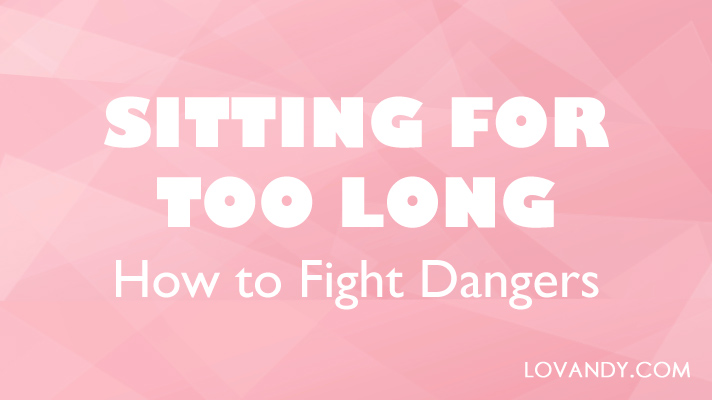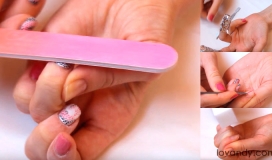When you sit for too long, you start feeling pain in legs, lower back and spine. These signs mean that your body does not like your position, and you have to do something. However, why is sitting so bad?
Dangers of Sitting for Too Long
The meaning of sitting is to give your body a break from movement and vertical position. The last one is the basic feature of the structure of the body, given to us by nature. Man is created to be in motion all day: moving to work, moving at work, walking and feeding children, gathering food, hunting, etc.
People who used to live and work in countryside sat only for the purpose of short-term rest. However, today this time has grown to an average of 13 hours a day, with sleep taking 8 hours and only 3 hours remaining for driving. It is very bad for your health.
Sitting is harmful, because it is an unnatural position for your body. The human spine is not designed to spend a long time in a sitting position.
Spine has an S shape, which makes it easier for the back to carry all your weight. When you sit, an S slowly becomes C. The more you sit, the more your spine is bent. Moreover, oblique and lateral muscles become weak and unable to support the body.
When you stand, the pressure is on hips, knees and ankles. And when you sit down, the entire pressure is transferred to the pelvis and spine. It is also increases in intervertebral discs.
According to magnetic resonance imaging, it is clear that even an ideally correct sitting posture causes serious pressure on the back.
Read more:
Feet Hurt from Standing All Day
Sitting is very dangerous for health, because the risk of diabetes or cardiovascular diseases is significantly increased. During each hour you sit, watching TV or listening to a lecture, your life is reduced by 22 additional minutes. This is because of blood clots, muscles getting weaker and spine getting tired.
Sitting is much more harmful than a simple immobility. Lying and standing are much more useful than sitting.
Recent research in various fields of epidemiology, molecular biology, biomechanics and psychology lead to an unexpected conclusion: sitting is a threat to public health. “People need to understand that seating mechanisms are completely different from walking or doing sports.” – says microbiologist from the University of Missouri, Mark Hamilton. – “Too sedentary lifestyle is not the same as lack of exercise is. For the body, these are two completely different things.” That is why even doing sport is not enough to keep your spine and muscles healthy.
How to Reduce Pain and Side Effects of Sitting
Considering mentioned, it is extremely important to fight and prevent any side effects of sitting. If you feel some pain in back, knees, ankles etc., you need to do something with your lifestyle to reduce these harmful effects.
Even if you do some sport, but spend a few hours per day sitting, you will face some health problems. The thing is, a regular physical activity is not enough to make your body rest and relax.
The best way to overcome most of the problems of sitting is to stand up and walk every time you can. For example, walk through the room every 30 minutes, stand up and look out the window. These simple things make your spine relax and blood circulate better.
Remember, that you need to do it all regularly, as often as you can.
Let us consider some more ways of preventing pain in back and legs when sitting for too long.
How Important is Proper Sitting Posture
A proper posture when sitting is one of the most important factors that affect your health. You need to sit properly so that there will be not much pressure on spine and neck.
This can help fight pain and some diseases as well:
- You should sit with a straight back. Buttocks should be on the back of the hard and straight seat. Loin should lean on the back of the chair, which has a physiologically right form.
- The seat of the chair should be flat and shorter than the hip. This is necessary to ensure that the edge of the chair does not deal much pressure on veins.
- The height of the chair from the seat to the floor should be the same as the distance from the hip to the floor.
- When sitting, the head should be pointed forward and upward, the neck relaxed, the spine straightened. When standing up, lean slightly forward, keeping your back straight.
- It is not recommended to sit in too soft armchairs for a long time. They make your muscles relax too much and your spine remains bent.
- Do not cross your legs when sitting, as your veins will be compressed too much.
Of course, you will need some time to learn the proper posture. At first, it will seem uncomfortable to you, but in time, you will feel complete relaxation from such sitting, as the body will be in a natural position.
Adjustable Standing Desk is a Beautiful Tool to Stay in Tonus at Work
Standing desk has many benefits compared with a regular one. The most important is posture. As we have learnt, when you sit, some muscles are not working to carry the weight of your body. Moreover, your spine is bent and strained. When you stand, on the other hand, everything works as it is meant to.
In addition to a proper posture, standing helps burn calories. You spend a lot more energy this way, so it may feel rather tiring. That is why there are adjustable standing desks. They can transform to a regular desk easily. Using such desk, you get all the benefits of both standing and sitting. Just alternate it every 30 minutes or so.
Neck and Shoulders Exercises to Do at Home
In addition to everything mentioned, it is a good idea to perform some exercises when sitting for long. It is better to do them regularly, like every hour or more often.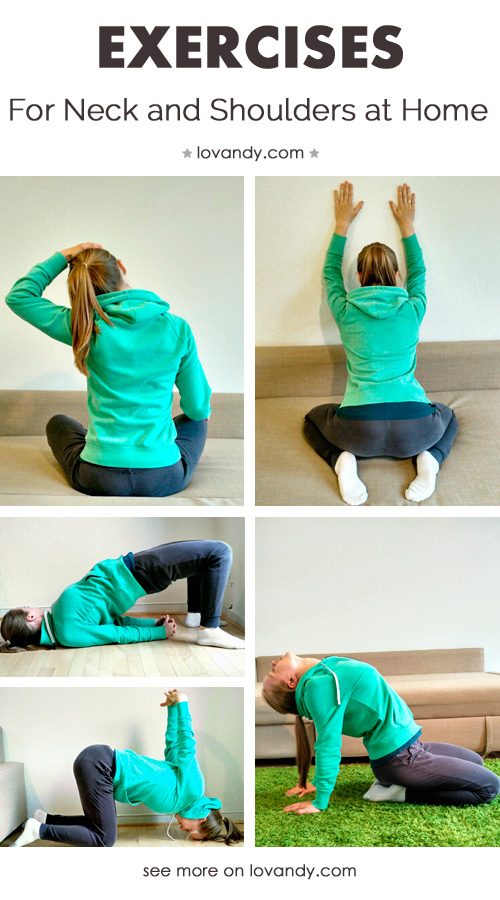
Exercise list:
- Put the palm of the right hand on the left side of the head and gently press, tilting the head to the right. The left hand can be pulled down and slightly to the side. During this exercise, the shoulders should be lowered, the back straight. Do it for 30 seconds.

- Sit on your knees in front of the wall. Lay a blanket or towel under them. Direct your knees in different sides. Pull your arms above your head, put your forearms on the wall and let gravity work for you. You can add a little effort and bend even lower. The head must be lowered down. If you do not feel the tension, move away from the wall a little further.

- This exercise will help to relax your neck and shoulders, as well as get rid of headaches and drowsiness. Sit on your knees and bend forward. Put your forehead on the floor. Stay like this for several breathes. Put your hands behind your back and raise them as high as you can. Inhale, raise the hips from the heels and carry the weight forward. Rest your head on the floor and try to keep your hands back as far as possible, trying to reach the floor.
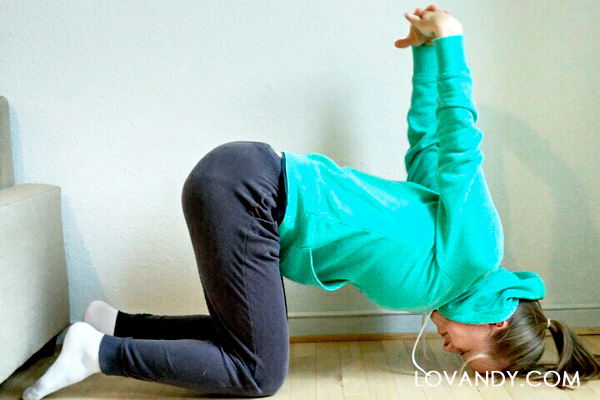
- Lie down on the floor, hands along the body with the palms down. Bend your knees, feet on the floor. Try to put your heels as close as possible to the pelvis. Make sure that your feet are shoulder-width apart and parallel to each other. Rest your hands on the floor and lift the pelvis up. Then, put your hands behind your back.

- Sit on your legs, heels under the pelvis. Lean back and put your hands on the floor with your fingertips back. Bend and try to lift your chest as high as possible. To increase the tension, tilt the head back.

Neck and Shoulders Exercises to Do at Office
Exercise list:
- Sit comfortably on the floor or on a chair, your back straight, your spine stretched out. Grab your head with your hands. The elbows point down to the hips. Begin slowly tilting your head down, hiding your chin in between collarbones. Sit in this position for 30 seconds, then remove your hands and slowly raise your head.

- This exercise can be performed at any time and in any place. It helps to stretch the lateral muscles of the neck Stand straight, feet shoulder-width apart, arms at the sides. Put your hands behind your back at the level of your pelvis and grab your left wrist with your right hand. Then slowly take your hands a little back. To increase the tension, tilt the head to the right shoulder.

- Sitting on a chair, slowly turn your head to the right shoulder and then to the left one. Repeat 10-12 times. This can be done every 15 minutes to keep your neck stretched and prevent stiffness.
- While sitting, grab the sides of your neck. Slowly tilt your head forward, then backward, to the left and to the right. Repeat this exercise more than 10 times. This is also pretty easy, so you can perform it anytime.
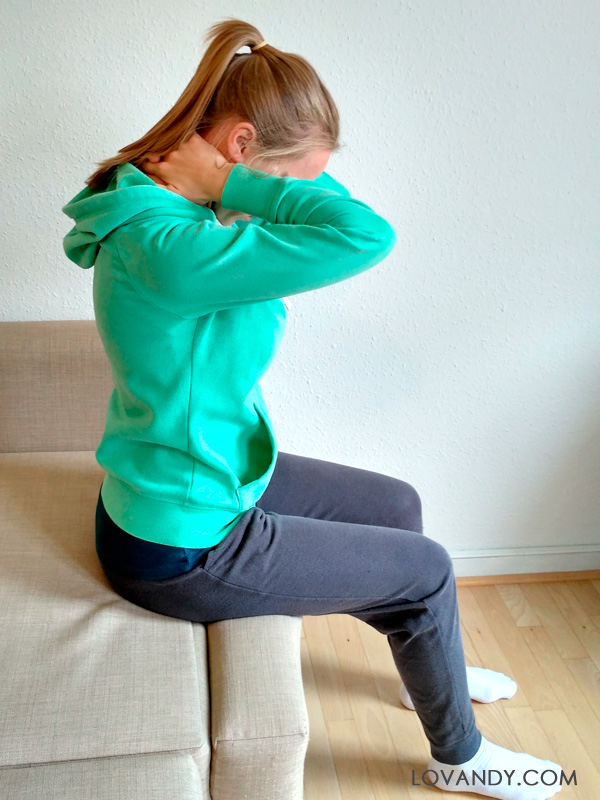
- Sitting on a chair, close your eyes and imagine that you are painting something with the tip of your nose. Perform a set of gentle movements. This exercise is really good for neck bones. It helps to relax the neck quickly.

Sitting can be very harmful for your health. Even if you do not feel any pain, it is rather bad to sit for too long. Everything we have considered should be done together to make it work best. Do not forget to do some sport and eat healthy food as well, so that your body feels good always.
Read more:
Benefits of standing desk

